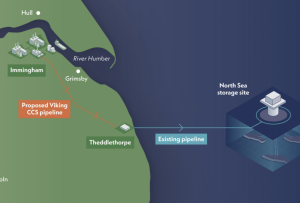Challenges and opportunities facing the energy sector in the North

By Rob Broom, Associate in the Energy & Natural Resources Practice Group at Squire Patton Boggs.
The importance of the energy sector in the north of the UK cannot be overstated: it provides an estimated 32,000 jobs and £2 billion of revenue, with a broad spectrum of activity and associated industries, from the world’s largest offshore windfarm at Walney, to fracking in Lancashire, to nuclear power generation at Heysham and Stanlow in Cheshire.
In 2017, the North accounted for 27% of the UK’s installed electricity capacity (dominated by conventional coal and gas thermal power stations), with 58% of that being located in the coal-rich regions of Yorkshire and Humber, according to a Northern Energy Taskforce Report. The government-funded British Geological Survey estimates that 1,300 trillion cubic feet of gas exists beneath the north west of England, Yorkshire and East Midlands. Indeed, the North is a colourful pallet of energy sources and opportunities.
However, each opportunity comes with its challenges. For example, the 3.4GW £15 billion nuclear new-build project at Moorside in Cumbria continues to face challenges to get underway, with a series of owners and no clear path to new investment. Such huge capital-intensive projects are only available to a select few, and Moorside seems to be lagging behind other new-build sites at Hinkley and Wylfa.
New technologies are facing stiff competition for funding, be it public or private, and must demonstrate commercial viability, including when compared against other established technologies. The Swansea Bay tidal lagoon project was rejected by the government for not providing “value for money” compared with other technologies on a contractual basis at 35 and 60 years for the same power output. The cost of the tidal project would be two and a half times that of Hinkley Point C, and the same power could have been obtained from offshore wind for £400 million (including asset replacement) over a 60-year timeframe.
This is despite the CFD strike price being less than that agreed for Hinkley Point C: the 90-year contract asked by the project developer (Tidal Lagoon Power) would have averaged at £89.90MW/h, prompting supporters of the project to claim that the goal posts have moved. Whatever view one takes of the financial aspects of the project, it demonstrates the commercial scrutiny projects face when seeking funding.
Following the 2016 government approval to go ahead with shale gas extraction at the Cuadrilla site at Preston New Road, a late injunction application (eventually dismissed by the High Court) to prevent Cuadrilla from hydraulic fracturing two horizontal wells on the basis of Lancashire County Council’s purported failure to assess safety risks further delayed the commencement of operations.
One of the main attractions of the UK has been political and regulatory stability. However, due to the uncertainty around Brexit and the impact of leaving Euratom, as well as changes to exemptions and tariffs, there is a fear that a lack of certainty could scare away green investment. Some of these changes include the removal of the Climate Change Levy exemption for electricity generated from renewable energy sources and the planned closure of the small-scale feed-in tariff on 31 March 2019, including the export tariff to new installations at the same time.
Despite such challenges, foreign investment demonstrates that challenges can be overcome: Danish Orsted (formerly Dong Energy) has invested heavily in the UK offshore wind sector, and EDF and China General Nuclear are significant investors in UK nuclear and renewables. Disposals in the renewables space, continuing investment at Wylfa, Hinkley and other large-scale energy sites, and the good performance of waste to energy, so-called micro-generation, solar and battery technology collectively show that investor appetite remains strong.
What are the opportunities?
The Energy Coast in Lancashire and Cumbria provides a platform for local expertise to develop a business cluster focused on nuclear, energy, environmental and related technologies. Local companies include Westinghouse, Cavendish, Urenco and Sellafield, and there are world-class (local) facilities at the Dalton Institute and the National Nuclear Laboratory. Decommissioning nuclear plants is not only a UK issue and skills developed in the UK are already being applied globally. Those skills are transferrable to nuclear new-build projects, as well as other energy projects or heavily regulated industries.
Energy demand is disproportionately high in the North due to the presence of energy-intensive commercial and industrial sectors. Real estate developers of any significant commercial, retail or housing developments more often than not have energy supply as part of their financial model: gas-fired CHP, providing power and heat/air conditioning, is an efficient way to meet the energy needs of those who will occupy the development.
Separately, UK battery storage (increasingly required to regulate grid frequency and integrate a growing amount of renewables) is predicted to enjoy explosive growth until 2022. In just 12 months, the UK’s pipeline for new battery storage projects has grown by more than 240%, with forecasted installations in 2018 set to rise by more than 200% year-on-year. These projects can obtain revenues from several sources, including the Capacity Market, STOR, EFR, FFR, Fast Reserve and under a PPA, and can often “stack” revenue sources together to underpin a project financial case.
In addition, more predictable fuel sources are making biomass and waste to energy plants more commercially viable and, therefore, more prevalent, particularly in small to medium scale plants.
For those looking at the more distant horizon, there are even more exciting opportunities, including (i) nuclear fusion; (ii) small modular nuclear reactors – nuclear power on a smaller scale from fission or fusion; (iii) power from closed fuel cells; (iv) hydrogen fuel cell vehicles; (v) carbon dioxide capture and underground storage; (vi) community energy schemes; and (vii) manmade hydrocarbons (where hydrogen and carbon are split off from water and carbon dioxide respectively and then joined to create the same chemical entities we use today).
As regards heat, the North has the attributes and natural advantages to lead in the take-up of new approaches, infrastructure and resources to underpin a low-carbon pattern of heat supply for the UK. For example, there exists the potential to convert significant parts of the gas network to run on hydrogen, which can be stored in the North’s extensive system of salt caverns.
Failure to exploit the North’s renewable expertise, assets and natural advantages would not just be a detriment to the region, but to the UK as a whole, in particular considering that in order to meet the fourth and fifth carbon budgets (covering the periods 2023 to 2027 and 2028 to 2032) the UK will need to accelerate the pace of decarbonisation.









